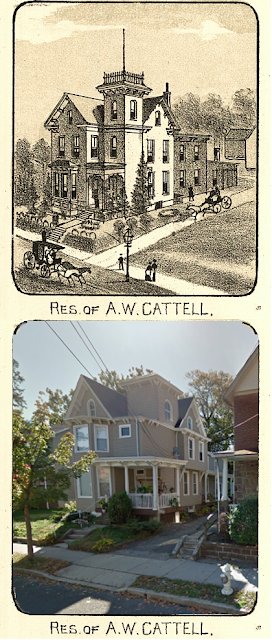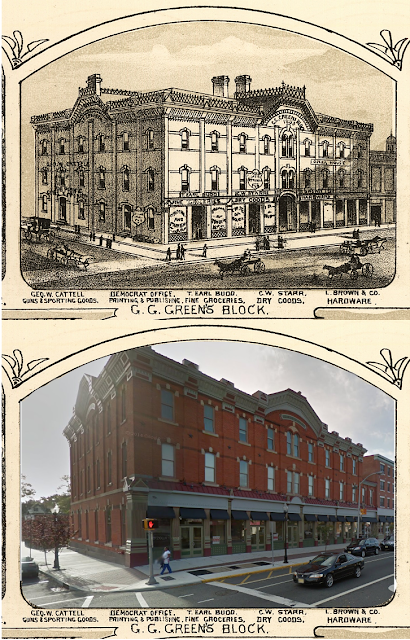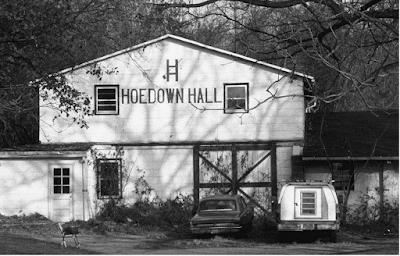The following dreadful tale is true. Upon moving to Woodbury I began hearing little snippets of stories and half-truths surrounding the shocking 1979 murder of the elderly widow Rose Twells which had occured in her stately circa 1880 colonial revival manse on a quiet historic section of Delaware Street. The case remained a mystery until recently. After so many years unsolved new information was brought to light in
2003 and again in
2008 regarding the case and 3 men were finally convicted for the heinous crime, but details regarding the original incident remained unclear in the new press that was circulating.
It wasn't until discovering Woodbury's own enigmatic Canon
William V. Rauscher's book,
Religion, Magic, and the Supernatural that I learned the whole story.
Religion, Magic, and the Supernatural is available for check out at the
Woodbury Public Library and is a fascinating read in its own right. With Canon Rauscher's kind permission the Chapter pertaining to the murder of poor Mrs. Twells is reprinted here in its entirety:
Murder in the Parish
Murder most foul, as
in the best it is; But this most foul, strange, and unnatural.
William Shakespeare
Hamlet, Act 1, Scene 5
The great King of
Kings Hath in the tables of his law commanded that thou shalt do no murder.
William Shakespeare
Richard III, Act 1, Scene 4
The Twells family is well remembered in Christ Church for
their generosity in memorial gift giving. Fittings for the Font, the Sanctuary
Gates, the original Pipe Organ, the Altar, a Memorial Window, the Altar Reredos
— all were gifts from this family so devoted to Christ Church.
One important member of the old Twells family was still
living when I ministered as Rector of Christ Church. This was John Stokes
Twells, a former mayor of Woodbury from 1935 to 1938, and a direct descendant
of Delaware's Caesar Rodney, who was one of the signers of the Declaration of
Independence. John and his younger wife Rose lived in a 14-room 140-year-old
house on Delaware Street, just down the street on the left from Christ Church,
and two doors away from the Davis Funeral Home.

Rose was a member of the Presbyterian Church in Woodbury.
She was also active in the Woodbury Women's Club, and served as a volunteer for
the Red Cross. For 15 years she taught in the Mantua Grove School in West
Deptford, New Jersey. Her husband, John, was a member of Christ Church, and
Rose saw to his spiritual needs by requesting that I bring him his Holy
Communion when he became too infirm to attend church services. I went to their
house regularly until his death in 1970.
The house in which John and Rose lived was a time capsule,
with old furniture scattered everywhere. As you entered there was a stairwell
next to a hall; John's former office was in the back of the house, and in it
was his old roll-top desk.
Rose was frail, demure, independent, and always pleasant — a
sweet, kind lady in the truest sense of the word. She led an orderly life,
loved her garden, and took long walks. Rose cared for John in his old age as
carefully as a nurse would care for a patient. By the time I knew the couple
John could barely hear, and when I said the prayers I spoke loudly. Rose would
always shout at the top of her lungs to announce my arrival, "JOHN, THE
RECTOR IS HERE!"
After John died Rose continued to live in the old house
despite concern about her living alone in such a large place. Celeste Twells
Edgcumbe, John Twells' niece, and her husband Charles lived directly across the
street, and often worried about her well being. They had always been very close
to "Aunt Rose," and checked on her daily.
The Edgcumbe family was active in Christ Church, and Charles
eventually became my Senior Warden. Celeste loved her association with the
Daughters of the American Revolution (D.A.R.), and when this group held
scheduled meetings with speakers who presented historical topics the gatherings
were held in the assembly room of Christ Church. None of us had any idea of the
dramatic role Charles would play in what happened on Thursday, December 20,
1979.
At 82 years of age, Rose planned a Christmas visit to
relatives who lived in Baltimore, but before she left she was to have dinner at
the Edgcumbes. It was a bitterly cold day with snow on the ground. That
afternoon I drove my car down Delaware Street on my way to Philadelphia, and as
I passed the Twells house I thought, "That's a spooky old place for Rose
to live at her age." When Rose didn't appear on time for dinner at the
Edgcumbe house, and did not answer her telephone when her niece called, Charles
Edgcumbe went across the street at 2 p.m. to check on her. When there was no
response to his knock on the front door, he used his key to enter the house.
And what he found at the foot of the stairs shocked him and stunned the entire
community!
Rose Twells had been brutally murdered — Charles found this
pitiful kind lady hanging by her feet from the banister at the foot of the
stairwell. Her ankles were tied together with an electric lamp cord, and she
had been bludgeoned to death with a three pound iron cauldron. Blood was
splattered everywhere.
Gloucester County
Times reporter and columnist Jim Six, who has followed the facts of the
case murder. since 1979, covered the story in its entirety, and later wrote
several additional follow-up articles. The city of Woodbury saw for itself the
photo of the police carrying Rose's body out of the house. Her funeral on
December 26, 1979 was held at the Presbyterian Church, conducted by The
Reverend Richard Craven, and under the direction of the Davis Funeral Home
(which was so close to the murder house). Rose was interred in the family plot
with her husband John (Lot #3260) in Eglington Cemetery, Clarksboro, New
Jersey. A large imposing stone marks the grave and is engraved with the name
"Twells."
And so Woodbury, New Jersey had a murder mystery on its
hands that would continue for the next 23 years. The city reflected the words
of the English dramatist John Webster when he wrote in The Duchess of Mafi, IV: 2, "Other sins only speak: murder
shrieks out."
Within the parish, rumors began to circulate as to who could
have committed such a horrendous crime. Rose had occasionally been helped by a
few young people who ran errands for her, and it was thought it might have been
one of them. It had already been decided a person who knew her had performed
this foul act. The police determined there was no sign of forced entry, and
found the back door unlocked, but there were no footprints or other signs since
snow had fallen and covered the ground. With such slim evidence and a possible
suspect, nothing was ever proven to warrant making an arrest, and the investigation
of the case continued for years.
Several members of the parish had their own ideas about the
perpetrator. Some of them would pull me aside and with utter conviction
whisper, "It was the Mayor's son!"
At that time the Mayor of Woodbury was a man named Frederick
Bayer. These people knew Rose was friendly with the Bayer family, including
their son who had occasionally performed odd jobs for her. Fred Bayer himself
was well liked. Years before, Fred had owned a moving company; in fact it was
he who moved me from Florence, New Jersey to Woodbury. I had never met his
adopted son Jeffrey, who was then 16 years old — but from information supplied
by parishioners I learned he was a troubled youth and a problem to his parents.
From the beginning Jeffrey was the prime suspect, but after being interviewed
more than six times in ten months many questions remained, and there was no
confession.
Shortly after the murder William Raynor, another
parishioner, asked to see me. Raynor was now a man of means, and as a young man
had acted as a chauffeur for John Twells. He was totally devastated by the
murder, and determined that the person who committed this vile act would be
found and prosecuted. One day he arrived at my office with $5,000 in cash
—reward money given by him, with the stipulation that the donor was to remain
anonymous. We deposited the money in the church accounts, and although the
reward was publicized, nothing ever came of it. Many years later the money was
returned to Mr. Raynor.
One night my rectory doorbell rang. There in the dim light
of early evening stood a short, stout woman known in the city as Emma Burton.
Emma was a fixture in the community who sold potholders. She was considered
eccentric, but was thought of as a kind woman. Emma said in a stern voice,
"Canon Rauscher, I am here to talk to you about the murder of Rose
Twells."
She followed me into my study, and rambled on about who she
thought had killed Rose. Actually she seemed sensible until she sailed into a
fantasy about the same people trying to gas her in her house by putting poison
in her furnace and pumping it into her hot air system. Her deluded information
was of no value, but I informed the police of her visit.
Even after I retired in 1996 I could never forget Rose
Twells' murder. Every time I passed the Twells house I remembered that terrible
night, even though by now the house had been sold to a real estate company.
Twenty-three years after the murder, and years after I had
retired Jim Six called me and said: "Big news is about to break from the
Prosecutor's Office." The Woodbury Police had just arrested three men for
the murder of Rose Twells. Jeffrey K. Bayer, age 39, Clifford M. Jeffrey, age
41, and Mark E English, age 41 were charged with first-degree murder,
first-degree felony murder, and first-degree conspiracy to commit murder.
Police, detectives, remaining family and many friends were relieved that after
all these years there would finally be a chance for justice. The police had
never given up on the case, but it took an informant who was associated with
the perpetrators to unleash the secrets leading to their arrests. This informant
was LouAnn Vennell-Waller, who was 17 years old at the time the murder took
place, and who had an intimate relationship with Bayer. Waller admitted she
had acted as a lookout while the trio went into the house to get money for
drugs. She named Jeffrey Bayer, her once boyfriend, as the person who grabbed
Rose after she fell on the stairs. When Rose recognized Bayer and threatened to
call his father, Bayer hit her in the head with the iron cauldron. Waller came
forth because she could no longer live with the memory of the crime, and for
her cooperation she received immunity from the prosecutors. When the arrests
were announced one woman in my former parish said, "See, I told you it was
Bayer! We all knew it from the beginning!" The words of the poet John
Dryden seemed appropriate to me at the time of the arrest when he once wrote,
"Murder may pass unpunished for a time, But tardy justice will o'ertake
the crime."
Bayer was charged as a juvenile, but then the legal debate
began to rage as to whether he or the others should be tried as juveniles or
adults. Finally it was determined they would be tried as adults.
On Tuesday, May 17, 2005 the trial began, and as it progressed
Jeffrey Bayer, a man with 17 prior convictions, admitted his many crimes as a
youth including stealing from his own parents, but he denied knowing Rose
Twells or ever committing the murder for which he was accused. The testimony
accumulated against him was overwhelming to the 12 jurors who deliberated for
three hours on Friday, May 27, until finally coming to a decision. The
Forewoman read the verdict — GUILTY of a felony murder. The jury determined
Bayer was a "party to a murder during the commission of another
crime." This is different from saying Bayer committed the murder with his
own hands. This decision is the result of legal problems when there is no DNA,
and only the testimony of witnesses is available. But nevertheless all
testimony for the prosecution led to his guilt, and Bayer, now 41 years old
dressed in a suit and tie, showed no emotion. On Friday, July 15, 2005 he was
sentenced by Superior Court Judge John Tomasello to thirty years in prison. The
jury deliberated for less than nine hours. He was spared the death penalty
because the court had to operate under the 1979 rules at the time the murder
was committed, but his 17 prior convictions influenced his sentence. Bayer's
accomplices, English and Jeffrey, would be tried separately. Court TV filmed
the entire trial considering the drama and intrigue of this case.
Suppose the case had never been solved? Suppose no one ever
came forward? Would justice ever triumph? I believe so, as I do in all murder
cases — but perhaps not on earth. The biblical truth is that we pay for such
beastly sins. If an earthly judge does not render a sentence, then we must face
our fate with a judgment upon our earthly life in another realm. Some might
argue this is not enough. Personally I think it is more than sufficient,
because this final judgment will take place in addition to any earthly
judgment. The suffering of consciousness after death is a prime factor in
divine justice — and we will be judged,
make no mistake about it, with a punishment far worse than any jail sentence or
death sentence handed out on earth.
As for Rose Twells, she is now cared for by a loving God who
received her into the arms of His mercy, and into Paradise. -
William V. Rauscher
_________________
















































